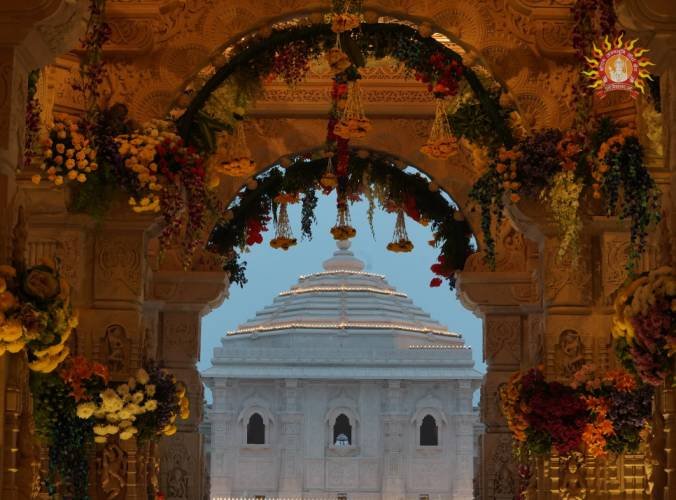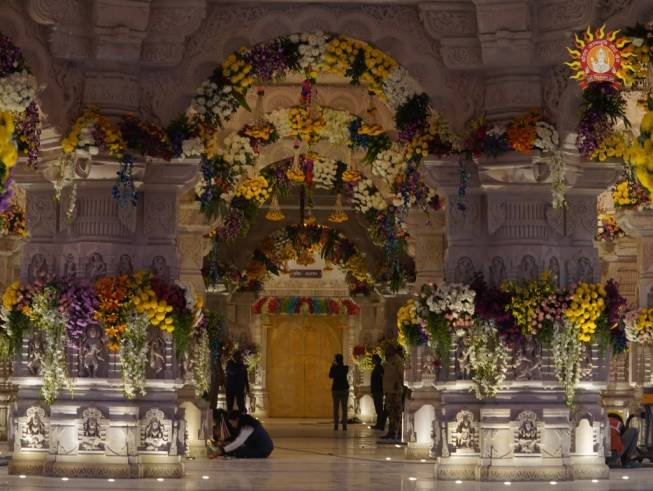Ram Mandir is set as tomorrow 22 January the temple will be inaugurated by Pm Narendra Modi. The concentration (Pran Pratishtha) ceremony of Ram Lalla ceremony is going to take place. The huge Ram Mandir in Ayodhya is a well-planned, skillfully accomplished, and stunning representation of Indian traditional history. This will be the proud moment for all the Hindus who live all over the world.
The Mandir constructed by renowned architect Chandrakant B Sompura, with the assistance of his son Ashish, and incorporates with his vision, which he outlined 30 years before.

Feature of the Temple
The temple is on 2.7 acres of land in the temple village. It measures 161 feet tall, 235 feet broad, and 360 feet long. It was built in Nagara style, one of the two distinct temple-building traditions of ancient India, and adheres to all Vedic ceremonies while using modern technology.
The temple surrounded by a huge courtyard and features several smaller shrines devoted to different Hindu deities. The temple’s most outstanding feature is the huge Shaligram stone and also a black stone which used to make the idol of Lord Ram that taken from Nepal’s Gandaki river.
By using the black stone Lord Ram idol is made by sculptor Arjun Yogiraj.
The temple’s built-up space is roughly 57,000 square feet, with three floors. The temple’s height is approximately 70% that of the Qutab Minar. The first floor of the Ram Mandir is dedicate to Lord Ram, Second Floor is dedicate to Lord Hanuman. The third floor is a museum which will show the history and culture of Ayodhya.
Nearly two lakh bricks imprinted with Lord Ram name in various languages have collected over the course of 30 years and are integrated into the temple.
The interior of the sanctum sanctorum embellished with Makrana marble, the same stone used to build the Taj Mahal.

Also read: Ram Mandir Inauguration: Ritual Schedule and Aarti Pass Booking begin
It stands on a high platform, with the most sacred part of the temple, known as the ‘garbha griha’ or sanctum sanctorum, towering over the largest shikhara or mountain peak on the third floor. A total of five such shikharas built throughout five mandapas. There are additionally 300 pillars across the mandapas, and 44 teak doors have erected.
No steel or iron used to built Ram Mandir.
During the Gupta Period, when the Nagara style arose, iron and steel not commonly used in temple construction. Iron has used for building mandir is a durability of about 80-90 years. The temple is made of granite, sandstone, and marble. It has a lock and key mechanism that insures it will last up to 1000 years. Notably, no cement or mortar have used in its construction. The budget of Ram Mandir Ayodhya is stands to cost around Rs 18,000 crore.
The area originally dug to a depth of 15 metres, then 47 layers of engineered soil deposited to form a stable foundation. To reinforce the structure, a 1.5-metre thick M-35 grade concrete raft built. Which followed by a 6.3-metre thick plinth of solid granite stone.
Science and tradition
A few prominent Indian scientists have helped to build the famed Ram Temple. ISRO technologies also used in the construction. Pradeep Kumar Ramancharla, director of the Central Building Research Institute (CBRI), has actively involved in the project.
A team of scientists from CBRI and the Indian Institute of Astrophysics (IIA) constructed a particular ‘Surya Tilak’ mirror, which is a lens-based equipment. It will utilise for a ceremonial anointment of Lord Ram on every Ram Navami day at noon, with sunlight shining on the idol’s forehead.
History of Ram Mandir
The Ayodhya Ram Mandir has a centuries-long history. The temple built on the site where Lord Ram, one of the most renowned Hindu deities, thought to have been born. The Mughal ruler Babur razed the temple in the 16th century, and a mosque built instead. The mosque, known as the Babri Masjid, stood on the site for centuries before being demolished by Hindu nationalist in 1992. It results in significant violence and communal tensions throughout the country.
For decades, the Ayodhya conflict has dominated Indian politics. The controversy centred on ownership of the ground where the Babri Masjid stood and whether it was Lord Ram’s birthplace. The Indian Supreme Court finally settled the case in 2019, ruling in favour of building a Ram Janmabhoomi temple on the site. The Shri Ram Janmabhoomi Teerth Kshetra, an Indian government-established trust, oversaw the temple’s construction.




